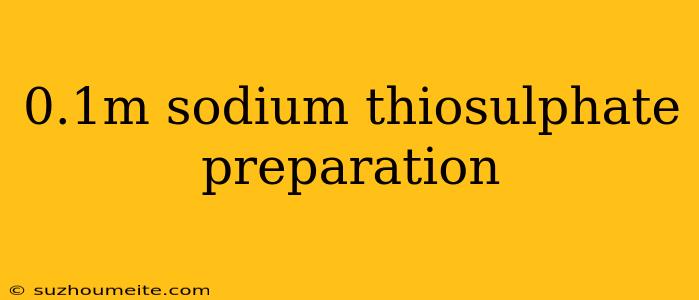0.1M Sodium Thiosulphate Preparation
Sodium thiosulphate is a strong reducing agent widely used in various laboratory applications, including the determination of iodine concentration and the study of oxidation-reduction reactions. To prepare 0.1M sodium thiosulphate solution, follow the steps outlined below:
Materials:
- Sodium thiosulphate (Na2S2O3) crystals
- Distilled water
- A 100 mL volumetric flask
- A weighing balance
Procedure:
Step 1: Calculate the Required Mass of Sodium Thiosulphate
To prepare 100 mL of 0.1M sodium thiosulphate solution, calculate the required mass of sodium thiosulphate using the following formula:
m = M x V x MW
where: m = mass of sodium thiosulphate (in grams) M = molarity of the solution (0.1 M) V = volume of the solution (100 mL or 0.1 L) MW = molecular weight of sodium thiosulphate (158.11 g/mol)
m = 0.1 M x 0.1 L x 158.11 g/mol = 1.5811 g
Step 2: Weigh the Required Mass of Sodium Thiosulphate
Using a weighing balance, accurately weigh out 1.5811 g of sodium thiosulphate crystals.
Step 3: Transfer the Sodium Thiosulphate to the Volumetric Flask
Transfer the weighed sodium thiosulphate crystals to a 100 mL volumetric flask.
Step 4: Add Distilled Water to the Flask
Gradually add approximately 80 mL of distilled water to the flask and swirl the mixture to dissolve the sodium thiosulphate crystals.
Step 5: Mix and Dilute to Volume
Mix the solution thoroughly and add more distilled water to the flask until the volume reaches the 100 mL mark.
Step 6: Mix Well and Label the Solution
Mix the solution well and label it as 0.1M sodium thiosulphate solution.
Precautions:
- Handle the sodium thiosulphate crystals with care, as they can cause skin irritation.
- Wear laboratory gloves and protective eyewear when handling the solution.
- Store the prepared solution in a cool, dark place.
By following these steps, you can prepare 0.1M sodium thiosulphate solution accurately and efficiently. This solution is now ready to be used in various laboratory applications.
